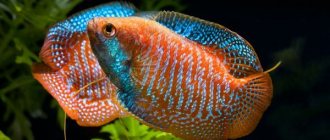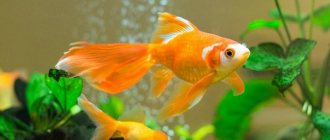Can I keep it with other fish?
Cockerels belong to the labyrinth fish that are able to breathe ordinary air with the help of a special organ. Species that are suitable for soft water and one-time feeding can live with cockerels.
When choosing neighbors for cockerels, it is important to consider the following points:
- Fish with long fins are not suitable for the neighborhood. The cockerels will attack them, mistaking them for rivals. Collisions can cause serious injury.
- Fish with a pugnacious character, like that of cockerels, are not suitable. Sooner or later, a fight will occur between them, which can lead to death.
- Cockerels do not tolerate cold water, so their neighbors must be comfortable with their favorable temperature conditions.
- You should not place fish that are too small or individuals that have not reached adulthood in an aquarium with bettas.
- Large or predatory fish will not like the cocky nature of bettas. They can be seriously injured in a confrontation with individuals that significantly exceed their weight. Up to and including death.
- It is recommended to house cockerels with other fish at a young age, before puberty. Then the fish will get used to its neighbors and will not be aggressive.
There should be at least 5 liters of water per rooster. If neighbors are added to the aquarium, then the volume has to be seriously increased. For a flock of 5 cockerels, experts say, you need an aquarium of at least 50 liters.
Description and character of cockerels
The body length reaches 5 centimeters. Thailand is considered its natural habitat. They live in bodies of fresh water. The color can be varied. There are individuals of yellow, red and green colors. Males become slightly brighter during the breeding season or during conflict with another individual. When light hits, the body shimmers with different colors.
In the aquarium industry, it was possible to breed a new specimen of female aquarium betta fish. Such individuals are extremely rare.
There are many stripes along the entire length of the body. There is a pointed fin on the chest. The dorsal fin extends all the way to the tail and has a more rounded shape. During a fight, the gills take the form of a collar, which is located around the head.
In Thailand there are special fights involving these creatures. There are bets on some fights.
Good neighbors
Among all aquarium fish, there are several species that are more suitable than others for good neighborly relations with bettas. These are mostly small and non-aggressive fish.
Botsiya
The bots are often housed together with the cockerels, but the aquarium must be filled with shelters - grottoes, castles, caves, so that the less active bots can take a break from the more active and pestering cockerels. It is recommended to place from 3 to 8 bots in one aquarium so that they do not feel lonely among other species.
Mollies
Mollies get along well with pugnacious cockerels. These are quite large fish that do not have the habit of biting other people's fins. The main danger in this union is the mollies fry - active cockerels can simply eat them.
Gourami
Gourami are relatives of cockerels, so they have the same cantankerous character. These two species get along well with each other, but provided that the aquarium has a capacity of at least 80 liters. Otherwise, the fish will be cramped, and the games will develop into conflicts.
Neons
These luminous fish coexist quite peacefully with mobile cockerels. The only thing that can create problems is some discrepancy in temperature conditions. The ideal parameters for this pair are +24..+25 °C - this is the lower limit for cockerels and the upper limit for neons.
Catfish corridors
Corydoras are aquarium orderlies who get along well with various fish, including cockerels. Catfish are considered excellent cleaners, live on the bottom, and practically do not interfere with scurrying bullies.
Catfish have a calm and accommodating disposition, and their body length reaches 13 cm. Corydoras do not tolerate organic matter dissolved in water, so it must be periodically replaced, at least 50% of the total volume of water.
Ancistrus
These modest fish with dull colors easily get along with a wide variety of fish. The length of ancistrus is 10 cm. Like bettas, these fish do not tolerate salted water and are kept in fresh water aquariums. To ensure a calm environment in the aquarium, it is filled with plants and shelters.
Tetras
These fish are very similar to cockerels in character and behavior, but this in no way interferes with their peaceful coexistence. Tetras tend to travel in flocks, so bettas do not attack them for fear of receiving a massive response.
Rasbory
These fish are quite active and mobile. They practically do not pay attention to the scurrying cockerels, which are inferior to them in size. But bullies aren’t particularly interested in rasboras. For a more relaxed environment, the aquarium is filled with plants that will suit both types of fish.
Pecilia
These fish, like mollies, have a calm and peaceful disposition. They can easily live with bettas in the same tank if it is large enough and filled with vegetation. It is recommended to add red and orange colors to the aquarium to make it more vibrant.
Ternetia
Thorns coexist peacefully with the cockerels in the same aquarium. They are released in small flocks. This species is quite mobile and is not attacked by cockerels unless they have long thin fins, which the cockerels will certainly bite on.
Cardinals
Cockerels have no conflicts with small and inconspicuous cardinals. Bullies simply don't see the Cardinals as competitors and aren't interested in them. Due to their inconspicuousness, cardinals feel comfortable in the same aquarium with bettas, moving around at their own discretion.
Snails
You can add snails into an aquarium with bettas, but always adults. If the snails are small, the cockerels will simply eat them. The fish take them out of the shells and eat them with pleasure. The best neighbors for cockerels are helenas and ampullarias.
Intraspecific neighborhood
As you can see, cockerels coexist not only with calm and peace-loving fish, but also with bullies. Alas, it is not possible to keep two bully cockerels together. This is especially true for males. They keep a close eye on each other and will definitely defend their territory in the event of an attack. And it will certainly happen, even if not in the first week after the two individuals meet. Often fights between these fish end in death, but even torn fins are not the best ending.
Aquariums with partitions are well suited for intraspecific proximity. 2, 3 and 4 section aquariums are popular.
Females are less aggressive, often containing 4-5 of them in a large aquarium. They coexist relatively peacefully even during spawning. But if there is a risk of a dangerous situation, then the aggressive fish is separated from the rest for a while.
It is also allowed to combine females and males in one aquarium. Acceptable: two or three females and one male. But an equal number of females and males (for example, two cockerels and two hens) is highly not recommended.
The patriarch is a beta with his chickens.
Relative compatibility
Along with favorable and unfavorable neighbors, there are fish that do not belong to any of these groups. They are considered to be of limited compatibility, since their cohabitation with cockerels carries certain risks, which increase if the conditions of detention are violated.
Angelfish
Majestic fish are quite capable of nipping cockerels by the fins. Their luxurious veils can be damaged by angelfish attacks. It is primarily adult fish that are dangerous. Young animals that grow up next to cockerels, as a rule, get along quite calmly with them.
Cichlazoma black-striped
This fish does not always get along with cockerels due to its pugnacious nature and habit of defending territory. They can get along with bettas, but only if the aquarium is very spacious and equipped with shelters.
Barbs
Most species of barbs have a cocky disposition. They are so active that they are constantly looking for victims to harass. Most often, barbs attack slow-swimming fish and those with long fins.
Bettas can also be attacked by barbs. To prevent damage from the actions of aggressors, bettas and barbs are kept only in large aquariums with plenty of cover and vegetation. There should be at least 6 barbs - this minimizes the risk of conflicts.
Minor
Minors are distinguished by their peacefulness and calmness. But they may have a desire to bite the fins of their neighbors. Minors can live together with cockerels, but in favorable conditions. It is necessary to monitor the behavior of the fish and, if necessary, remove the aggressors in time.
Lyalius
These are labyrinth fish, and they always coexist well with their relatives in the group. Bettas can sometimes attack lalius, so the aquarist must vigilantly monitor the behavior of the fish in the aquarium.
With whom is cohabitation possible, but not very desirable?
There are fish with which bettas can, of course, cohabit, but it is better to avoid this or create special conditions for each species. For example, a botia is suitable as a neighbor for fighters if it lives in a group of up to 8 individuals. It is also mandatory for them to have decorative elements in the aquarium. Otherwise, they are not guaranteed a normal life.
Rasboras can live with bettas due to their agility. It is this quality that allows them to simply run away from offenders during conflicts. However, you will need to install various shelters so that they have somewhere to hide in case of danger.
Tetra, if it is solitary, is aggressive, therefore, in order to avoid conflicts with cockerels, it is advisable to house representatives of this species in flocks. Cohabitation is also facilitated by the presence of algae and various decorative elements.
It won't be the best to be around guppies. Firstly, these fish need different characteristics of aquarium water, and secondly, during the race, guppies may be left without their luxurious fins.
It is not advisable to house fighters with barbs, swordtails, goldfish, and some catfish. It is better to keep these types of fish separately from the bettas. If there is a strong desire to make them neighbors, a good option for doing this would be to release fry of the desired species of the same age as the fry of the cockerels. They will get used to each other from a very young age and will not compete.
Pecilia and ternetsia can coexist, but only if special conditions are created.
Incompatible species
Some fish are strictly contraindicated in proximity to cockerels. They can be divided into three groups - the first can suffer from the aggression of cockerels, the second itself poses a danger to bullies, and the third are not suitable for the conditions of detention.
Guppy
These fish should not live with bettas, since as a result of their proximity, the fins and tails of smaller individuals may suffer. In addition, the small size of guppies provokes aggression in males.
Goldfish
These beautiful fish cannot live together with bettas due to different requirements for the temperature range of the water. In addition, the fish differ significantly in size, and the veiled fins of goldfish run the risk of being bitten by cocky bettas.
American cichlids
These are large aggressive fish that look at bettas and other small fish solely as prey. If you introduce bettas into an aquarium with American cichlids, the latter will be immediately eaten.
African cichlids
These are aggressive fish that tend to destroy any small fish. All neighbors who are inferior in size to territorial cichlids run the risk of becoming their victims. Cichlids will simply kill the bettas.
Tetraodons
These fish belong to the Four-Toothed family. They are very confrontational and do not get along well with their neighbors. Tetraodons will definitely tear off the fins of the cockerels. In addition, these fish love salted water, but it is contraindicated for bettas.
Cherry shrimp
Due to the small size of cherry shrimp, as well as other species, they often become prey for active and voracious bettas. Shrimp are especially often eaten after molting and at a young age.
General principles for keeping betta fish with other fish species
- It is necessary to limit proximity to species with brightly colored bodies. There is a possibility that the cockerels will incite conflict.
- Do not release them into an aquarium with predatory animals. This can be dangerous for betta fish.
- The temperature range of the tank must be uniform. Some fish species cannot live with bettas because they cannot tolerate warm water.
- If you plan to live next to other inhabitants, you need to equip the aquarium with plants and decorative elements. The fish will find shelter and conflict situations will rarely arise.
Previous
Varieties of Astronotus: maintenance and care of aquarium fish, compatibility, feeding, description, breeding cichlids in an aquarium
Next
Varieties of Glass perch (colored, Indian, transparent, colored aquarium fish Changa ranga): maintenance, compatibility, breeding (reproduction), photo
Great article 0
Is it possible to keep two bettas in one aquarium?
Cockerels are aggressive, so it is not recommended to keep them in groups. Especially conflicting males. They are cocky and constantly fight for territory, injuring each other. A fatal outcome is excluded, but the fins will be seriously damaged.
Females are not so aggressive, and can live 4-5 individuals in an aquarium. If one of the fish shows increased aggression, you have to move the individual to a separate aquarium. The best option is one male and several females. Then the likelihood of conflicts will be minimized.
What to look for?
The situation in the aquarium largely depends on the conditions of detention. The better they are, the greater the chances for peaceful coexistence of the inhabitants of the aquarium.
Aquarium volume
A tank holding 10 liters of water is enough for one rooster. For several fish you need larger containers. The more spacious the aquarium, the more comfortable and peaceful the existence of the bettas will be.
Decorations and shelters
Active and temperamental fish like bettas definitely need places to hide. Females often get tired of the male’s advances, so they hide in grottoes and caves, among dense vegetation.
The presence of various types of shelters allows you to defuse the situation in any aquarium. If one of the fish wants to retire and take a break from overly active neighbors, they can hide in shelters prepared for them.
Controlling cockerel behavior
If bettas are kept in an aquarium with other fish, the aquarist should carefully observe their behavior. It is important to control the relationship between cockerels and neighbors. If conflicts are brewing and the fins are under attack, it is necessary to remove the aggressor.
Features of living alone
If there is a conflictual atmosphere in the aquarium, do not panic. The problem will be solved by placing aggressive fish in a separate aquarium. Cockerels easily tolerate loneliness, and practically do not worry about the lack of companions.
Cockerels, despite their quarrelsome and conflicting disposition, with proper organization of life in the aquarium and with the right choice of neighbors, can lead a completely peaceful life. Their complex character is more than compensated for by their special fishy “charisma” and excellent external data.
Who is it contraindicated to be in proximity to?
Under no circumstances should you add snails to your cockerels. The fighting nature of fish tells them that small individuals are excellent for feeding. Although cockerels can also cause harm to larger specimens of mollusks, for example, by biting off their antennae.
Shrimp are also not suitable for proximity to handsome creatures. After all, predatory cockerels will probably want to feast on them. From here it is worth concluding that you should not place any very small fish and other harmless inhabitants of aquariums with them.
A peaceful life will not be possible for cockerels with black-striped cichlas, discus, brightly colored parrots, eels, and astronotuses.











